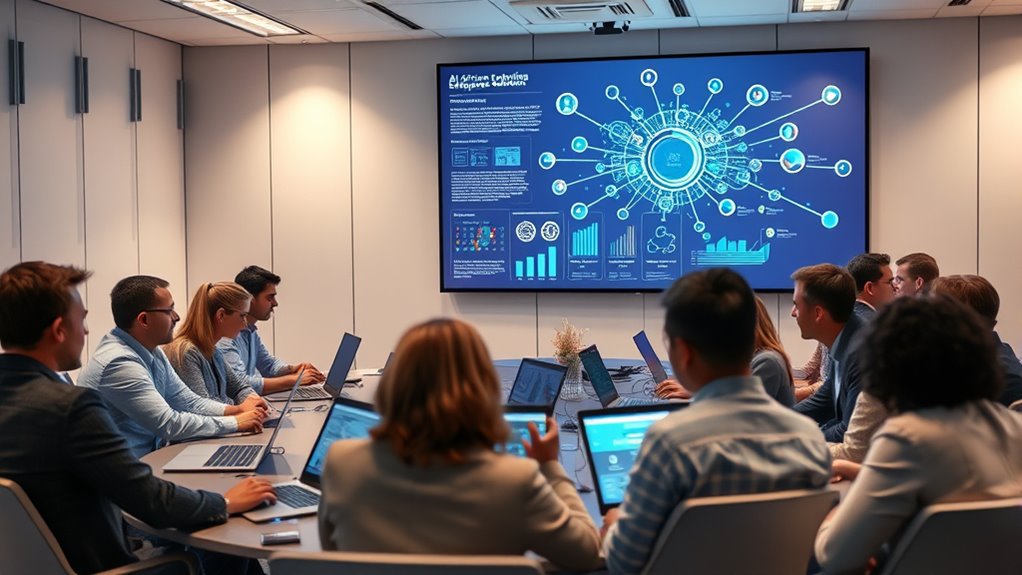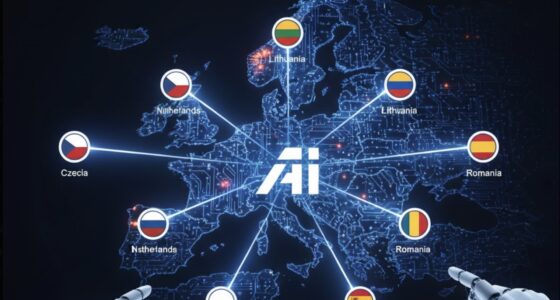Generative AI is already transforming enterprises by enhancing content creation, automating customer support with AI chatbots, streamlining manufacturing processes, and improving professional services like legal and data analysis. Companies are saving costs, boosting efficiency, and fostering innovation through these real-world applications. If you want to discover specific case studies and how organizations leverage AI to stay competitive and agile, there’s more to explore in this evolving landscape.
Key Takeaways
- Companies like Merge have improved marketing efficiency by up to 33% using generative AI for content creation and personalization.
- AI chatbots enable 24/7 personalized customer support, automating routine inquiries and enhancing client interactions.
- Manufacturing firms utilize AI-driven predictive maintenance and automated design processes to reduce downtime and waste.
- Legal and professional services automate document review, data analysis, and compliance checks, accelerating insights and reducing manual effort.
- Generative AI streamlines workflows across industries, boosting operational agility, reducing costs, and fostering innovation.
Content Creation and Marketing Optimization

Generative AI is transforming content creation and marketing by enabling businesses to produce high-quality materials with minimal human effort. You can now generate compelling ad campaigns, blog posts, and social media content quickly and efficiently. This technology analyzes existing data to craft tailored messages that resonate with your target audience, saving time and reducing costs. Marketing teams leverage AI tools to streamline workflows, allowing them to focus on strategy and creativity rather than repetitive tasks. As a result, campaigns become more consistent and personalized, enhancing engagement. Companies like Merge use generative AI to boost marketing efficiency by up to 33%. Additionally, understanding asset division principles can help businesses effectively allocate resources during growth or restructuring phases. With AI handling content production, you gain a competitive edge, delivering fresh, relevant content faster and more effectively than ever before.
Enhancing Customer Support With AI Chatbots

Building on the advancements in content creation and marketing, AI chatbots are now transforming customer support by providing immediate, personalized assistance. You can engage customers around the clock, addressing inquiries without delays. These chatbots use natural language processing to understand context and deliver responses that feel human. They automate routine tasks like order tracking, account management, and FAQs, freeing your support team for complex issues. Personalized interactions help build stronger customer relationships, boosting satisfaction and loyalty. Additionally, AI chatbots analyze customer data to identify patterns and suggest proactive solutions. With continuous learning, they improve over time, becoming more efficient. Incorporating best modern toilet insights can further enhance service offerings related to bathroom-related customer inquiries. Overall, AI chatbots streamline support workflows, reduce operational costs, and enhance the customer experience in real-time.
Generative AI in Manufacturing and Product Development

You can leverage generative AI to optimize your product designs, reducing material costs and enhancing durability. It also helps streamline production workflows, making manufacturing processes more efficient. By adopting these tools, you’ll accelerate innovation and improve overall operational agility. Incorporating efficient manufacturing processes through AI can further improve productivity and reduce waste.
Optimizing Design Processes
Optimizing design processes in manufacturing and product development has become increasingly efficient thanks to generative AI. It enables you to rapidly explore design options, reduce material costs, and improve product durability. By automating iterations, you can shorten development cycles and innovate faster. Generative AI also assists in identifying ideal configurations, balancing performance and cost. Here are key ways it transforms design workflows:
- Creates multiple design alternatives quickly
- Reduces material waste through optimized structures
- Enhances product durability and performance
- Accelerates prototyping and testing phases
- Supports customization for specific client needs
This technology empowers you to make data-driven decisions, streamline collaboration, and stay ahead in competitive markets. By integrating AI into your design processes, you access new levels of efficiency and innovation. Additionally, it can help you incorporate Bedroom design principles to ensure the final product aligns with user comfort and aesthetic preferences.
Streamlining Production Workflows
Generative AI is revolutionizing manufacturing and product development by automating complex workflows and enabling real-time decision-making. You can deploy AI to optimize production schedules, reducing delays and increasing throughput. It analyzes sensor data from equipment, predicting failures before they happen, minimizing downtime. In product development, AI accelerates prototyping by generating multiple design options based on performance criteria, saving time and costs. You can also use AI to streamline quality control, automatically detecting defects and inconsistencies during manufacturing. This technology facilitates seamless coordination between teams, ensuring smoother operations across the entire supply chain. Incorporating well-being tips into workplace practices can further enhance employee productivity and satisfaction. By integrating generative AI into your workflows, you enhance efficiency, reduce waste, and respond swiftly to market demands, giving you a competitive edge in today’s fast-paced manufacturing landscape.
Transforming Professional Services With AI Tools

Professional services firms are increasingly adopting AI tools to streamline their workflows and enhance client interactions. These tools enable faster, more accurate delivery of services, freeing up your team to focus on strategic tasks. AI-driven applications like chatbots improve client communication by providing instant, personalized responses. Generative AI also assists in automating routine tasks, increasing efficiency and reducing human error. You can leverage AI for generating reports, summarizing legal documents, or analyzing complex data quickly. This adoption of AI can also include content generation to produce engaging and relevant materials for clients and internal use. This results in shorter turnaround times and higher client satisfaction.
Use Cases in Data Processing and Legal Analysis

AI tools are transforming data processing and legal analysis by automating complex, time-consuming tasks. You can now quickly review large volumes of documents, extract key information, and identify relevant clauses with minimal human effort. Generative AI helps legal teams draft contracts, summarize lengthy legal texts, and guarantee compliance by flagging potential risks. In data processing, AI automates data cleaning, categorization, and pattern recognition, accelerating insights and decision-making. You gain faster turnaround times, improved accuracy, and reduced manual workload. This automation allows your team to focus on strategic analysis rather than routine tasks. Additionally, integrating diverse designs into AI-driven workflows can enhance the overall effectiveness and adaptability of these systems. As a result, you enhance efficiency, reduce errors, and assure better compliance, making AI an indispensable tool for streamlining legal and data workflows in your enterprise.
AI-Driven Design and Workforce Insights

When integrated effectively, design teams can leverage AI-driven tools to optimize product concepts, reducing material costs and enhancing durability. These tools analyze vast data sets to suggest innovative designs, simulate performance, and refine prototypes rapidly. With AI insights, you can also predict workforce trends, identify turnover risks, and plan hiring accordingly. This enables smarter HR decisions and proactive talent management. AI-driven design accelerates development cycles, minimizes waste, and improves product robustness. Workforce insights help you allocate resources better and tailor training programs. Additionally, understanding dog breeds can inform personalized training approaches and improve team dynamics within organizations.
Impact on Business Efficiency and Cost Reduction

Generative AI can markedly boost your business efficiency by automating content creation and streamlining workflows. You’ll save time and reduce costs by minimizing manual tasks and optimizing operational processes. As a result, your organization can focus on strategic growth while cutting expenses. Additionally, AI security measures ensure that sensitive data remains protected during these automated processes, further safeguarding your business integrity.
Automating Content Generation
Have you noticed how automating content creation can substantially boost your business efficiency and cut costs? With generative AI, you can generate high-quality content quickly, freeing your team for strategic tasks. This automation streamlines workflows and reduces reliance on external agencies, saving money. You can also produce personalized marketing materials at scale, enhancing customer engagement. Additionally, AI tools help maintain consistency across channels and update content swiftly in response to market changes. Effective keyword research ensures your content aligns with what your target audience is searching for, maximizing its impact.
Streamlining Operational Processes
Streamlining operational processes with generative AI can substantially boost your business’s efficiency and reduce costs. You can automate routine tasks like document review, claims processing, and report generation, freeing up your team to focus on strategic activities. AI-driven predictive maintenance minimizes equipment downtime, saving money and avoiding delays. In manufacturing, generative AI optimizes design and production workflows, lowering material waste and speeding up product development. Additionally, AI-powered chatbots and virtual assistants handle customer inquiries instantly, reducing staffing needs and improving service quality. By integrating these solutions, you’ll create a more agile operation that responds quickly to changing demands. Overall, generative AI enables you to cut operational expenses while increasing productivity, giving your business a competitive edge in today’s fast-paced market.
Future Trends and Industry Adoption Patterns

Are industry adoption patterns for AI set to accelerate in the coming years? Absolutely. You’ll see increased integration across sectors, driven by advancements in technology and proven ROI. Key trends include:
- Growing focus on personalized customer experiences through AI-powered interactions.
- Expansion of content creation tools that minimize human effort while maintaining quality.
- Wider deployment of AI-driven chatbots for seamless, natural conversations.
- Automation of complex processes like claims processing and legal document analysis.
- Cross-industry adoption from manufacturing to professional services, boosting efficiency and innovation.
As organizations recognize AI’s strategic value, you’ll notice a shift toward scalable, high-impact solutions. Industry leaders will continue to invest heavily, making AI a core driver of competitive advantage in the future.
Frequently Asked Questions
How Does Generative AI Ensure Data Privacy and Security in Enterprises?
You can guarantee data privacy and security with generative AI by implementing strict access controls, encryption, and regular audits. Use anonymization techniques to protect sensitive data and establish clear policies for data handling. Incorporate secure infrastructure, like firewalls and intrusion detection systems, and monitor AI activity continuously. Collaborate with security experts to stay updated on emerging threats, ensuring your enterprise maintains confidentiality and compliance throughout AI deployment.
What Are the Main Challenges in Scaling AI Solutions Enterprise-Wide?
You face several challenges when scaling AI solutions enterprise-wide. First, ensuring your data infrastructure is robust enough to handle increased data flow is critical. You also need to address integration complexities with existing systems, which can be resource-intensive. Scaling requires careful planning around cost, maintaining performance, and managing human-AI collaboration. Finally, establishing clear metrics helps you measure success and justify further investment in AI initiatives across your organization.
How Do Companies Measure ROI From Generative AI Projects?
You measure ROI from generative AI projects by tracking key metrics like cost savings, time reductions, and revenue growth. You compare pre- and post-implementation performance, analyze improvements in customer satisfaction, and evaluate efficiency gains. You also consider strategic benefits such as enhanced innovation and competitive advantage. By setting clear goals and monitoring these indicators regularly, you gain an extensive view of how your AI investments translate into tangible business value.
What Skills Are Essential for Implementing AI in Business Processes?
You need a mix of technical and business skills to implement AI effectively. Focus on data analysis, machine learning, and coding to handle technical tasks. Develop project management and change management skills to navigate organizational shifts. Strong communication is essential to explain AI benefits and collaborate with stakeholders. Additionally, understanding industry-specific processes helps tailor AI solutions, ensuring they align with business goals and deliver measurable value.
How Does Generative AI Impact Traditional Job Roles and Workforce Dynamics?
Generative AI transforms traditional job roles by automating routine tasks, allowing you to focus on strategic, creative, and complex activities. It shifts workforce dynamics, making skills like oversight, data analysis, and human-AI collaboration more valuable. You might find your role evolving to include managing AI tools or interpreting AI-generated insights. Embracing these changes helps you stay relevant, boost productivity, and open new opportunities within your organization.
Conclusion
As you explore the evolving landscape of generative AI in enterprise, you’ll find it gently reshaping how businesses operate, innovate, and serve their customers. While change often brings new opportunities, it also invites a thoughtful approach to integration. Embracing these advanced tools can subtly enhance efficiency and creativity, paving the way for a more seamless future. With careful consideration, you’ll position your organization to thrive in this sophisticated era of AI-driven transformation.









